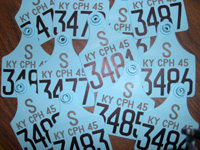CPH-45 Sales Worthwhile Even In High Cattle Market
CPH-45 Sales Worthwhile Even In High Cattle Market

Preconditioning calves for the CPH-45 program can still offer advantages to producers even in a year with already high prices, say University of Kentucky College of Agriculture beef specialists.
For beef producers considering selling calves directly off the cow and not preconditioning the animals, a look back through the program’s history tells them the effort is worthwhile, said Roy Burris, UK Extension beef cattle specialist.
The CPH (certified preconditioned for health) program basically requires a certain health standard for calves sold through the program, such as proper weaning and immunizations. Calves sold under CPH-45 are tagged for identification and grouped by grade and breed in order to create large lots of healthy, uniform calves. Health records assure the proper vaccination of the animals and build confidence among potential buyers. Local sales may have additional requirements.
An analysis of 11 years of data from the Pennyrile CPH-45 sale at Hopkinsville , along with price data from regular sales, reveals that program participation consistently pays off for the producer.
“Based on history, what we’ve seen is that you make your most money when calves are high because the biggest economic advantage comes from weight gains not premiums,” Burris said. “The buyers of preconditioned calves are generally looking for calves that are heavier so we don’t see much of a price slide. Also, these sales are more beneficial to the buyers when cattle are high because of the health standards and lower likelihood of calf loss.”
Normally, the price drops per pound as the weight goes up. Data shows that in regular sales every year except one saw higher prices for calves weighing 550 pounds sold in October than prices received for 650-pound calves sold in December. The decline averaged a negative $3.99 per hundred pounds. However, 650-pound calves selling in the December CPH-45 sales at Hopkinsville saw a price increase on average of $2.82 per hundred.
Net returns over the 11-year period showed an added value of $58.92 per calf for those sold in the CPH-45 sale compared to calves sold at weaning. In 2003 when calf prices were approaching historical levels, producers in the Hopkinsville sales saw their highest net returns of $97.33.
“Where we see most of the money being made is being able to put rapid efficient gains on calves,” Burris said. “In a 45 day period 120 to 150 pounds can be put on a calf. My research has surprisingly shown that the best gains are made in the first 20 days. Also, when you wean them on the farm, there’s less stress than when they are transported off-farm.”
By utilizing commodity or home-raised feeds, weight gain can often be achieved at a cost in the low 30-cent per pound range. This allows producers to add weight to calves efficiently and cheaply then take advantage of market demand later in the year.
“When I get the opportunity to put 30-cent gain on $1 plus per pound calves, I’m going to take it,” Burris said.
For more information about the CPH-45 program, contact a county office of the UK Cooperative Extension Service.
-30-
